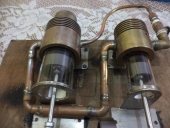
 3
3








Inresol is not shipping engines at this time due to technical and financial issues, Qnergy in Utah is only company I know selling quality Sterling engines at this time.




 2
2




I make a Maple Syrup instructional movie! Check it out HERE
SKIP books, get 'em while they're hot!!! Skills to Inherit Property
See me in a movie building a massive wood staircase:Low Tech Lab Movie
 1
1




 1
1




Mike Jay wrote:I saw a kickstartereque video of Sefton Motors and it looked like fun. I'd love to have a way to turn woody biomass into electricity.
Ashley Reyson wrote:Brian, thank you for this topic. Please keep us in the loop as you learn more. I stopped watching Stirling engines a few years ago, but I agree that coupling one with a RMH is interesting.
If they want 1000C, I'm curious about their materials on the hot end, and especially how much higher they could handle without damage.
If the form factor works, I'd love to mount the hot end directly above the J tube, right in the center of the barrel. It poses some interesting fabrication challenges sealing the joint, but placing it there has two big advantages...
Peak temperature input for the Stirling engine Positioning the cooling effect there should help the barrel's down draft.
If this starts to look viable, I'll enjoy calculating the amount of firewood necessary to produce 10kw for an hour. I'm not sure what that implies for the scaling of the oven.
 1
1




 1
1








Ashley Reyson wrote:I think you're right that Qnergy isn't in the game at that level. As fun as stirling engines are conceptually, if the goal is electric power generation from wood, one can purchase a turnkey wood gassifier with generator that has much more output for much less money.
The Melvin engine may be a start, but now that you're getting me interested in this topic again... I think a serious focus on wood powered electricity requires some adjustments to that approach.
Ashley Reyson wrote:
If I recall correctly, an ideal stirling engine's efficiency is carnot efficiency, meaning that it's efficiency is a function of the hot/cold temperature differential.
That implies that we'd be nuts to not put the hot side of the stirling engine in the highest temperature place possible. A first cut at that would be right on top of the J tube, certainly not heat transfer via a hose.
The limiting factor in this is of course the materials in the engine. My recollection from Paul's 8 DVD set is that the innovator's event RMH's of the last few years are routinely running around 2500F and some are getting above 3000F.

|
All that thinking. Doesn't it hurt? What do you think about this tiny ad?
Play Your Way to a Sustainable Lifestyle: Uncover Permaculture Principles with Each Card
https://gardener-gift.com/
|






